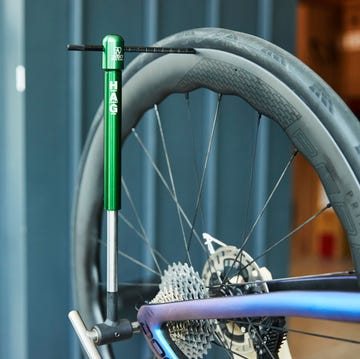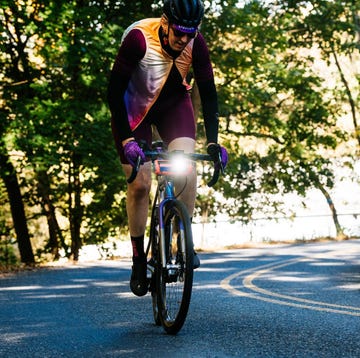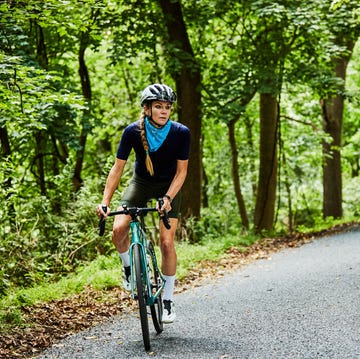How often do you take the time to focus on your breathing while cycling? We’re going to assume not much. But that could be holding you back on your rides, considering learning to take deep, quality breaths while you pedal can change your performance game.
Labored, high-paced breathing isn’t doing you any favors. Taking shallow breaths from your chest rather than filling your belly with air limits the amount of oxygen coming in, which means your muscles don’t get the oxygen they need to perform. All this causes your heart rate to rise, your blood pressure to go up, your circulation to reduce, and your stressed body to go into “fight-or-flight” mode, which can make you more emotionally reactive. In other words, it makes tough rides less fun—and slower.
But how do we change such a fundamental habit? Al Lee, author of Perfect Breathing: Transform Your Life One Breath at a Time, has a few ideas. “Breathing efficiency is like improving your gas mileage: Studies have shown that with a bit of training, you can improve your breathing efficiency into the 10-percent range, which translates into a 3- to 5-percent improvement in performance,” he says. That’s a lot of performance benefit for very little work.
Here’s what you should know about maximizing your riding potential through proper breathing, which helps deliver oxygen to those muscles that need it most.
The Importance of Breathing
“Every cell in your body needs a constant and immediate supply of oxygen,” Lee says. We can survive for days without food, but without air, only minutes. “Ninety percent of the energy your body uses comes directly from the breath,” Lee adds. That’s a lot of energy, which means small positive changes in your breathing methods really do add up.
Plus, regularly practicing breathing exercises can calm your nervous system, helping you fight off stress, and research shows it can have a major effect on physical health markers, like blood pressure.
How to Improve Your Breathing While Cycling
Focus on Belly Breathes
One big secret to maximizing your oxygen uptake is learning to take deep breaths—belly breaths a.k.a. diaphragmatic breathes if you’ve ever been to a yoga class.
The key to deep breathing is recruiting your diaphragm, a flat muscle that extends across the bottom of your ribcage, which helps push as much air through your body as possible. “When you inhale, it flexes downward and creates a vacuum,” Lee says. “That causes breath to rush in through your nose and mouth to your lungs… It’s like a bellows.”
Your diaphragm can only do its job if make space for it. “Whether you’re sitting at a desk, driving a car, or hunching on the bike, you’re sitting a lot, and that crimps the space that the diaphragm expands into, so we don’t breathe deeply,” Lee says. When we limit how much our diaphragms can function, breath takes the path of least resistance and moves higher and higher into the chest, resulting in shallow breathing.
So before you even focus on your breathing itself, revamp your insides. Spend less time seated; straighten up to allow your belly and ribs to actually expand; and strengthen those abdominal muscles to get out of the shallow breathing habit.
Watch a Baby Breathe
If you want to see how you should be breathing, look at someone a lot younger and less wise than yourself. When you watch a baby breathe, says Lee, you see how you should be breathing. “It’s like they have a balloon in their stomach,” he says. “It just expands and falls back so naturally.” That’s what you want to get back to. “We slowly squeeze that out of people as they go into adolescence and adulthood, and we get into a really unhealthy pattern,” he adds.
Count It Out
Practice deep breathing off the bike before you worry about how you breathe while cycling, Lee says. “We normally breathe between 15 and 20 times per minute, but research has shown that if we can get our breaths down to 10 per minute—six seconds per breath—that’s when we get the best benefits from breathing,” he explains.
These benefits include lowered blood pressure and heart rate, expanded arteries for better circulation, reduction in inflammation in veins and arteries, a change in the blood chemistry to make it less acidic, and less panic and anxiety thanks to that shift in blood chemistry.
“Slow, deep breathing breaks a panic cycle,” says Lee. “And it boosts your immune system too.”
Spend five minutes per day timing your breathing—three seconds in, three seconds out—and Lee believes you’ll start to see a change. “Everyone has five minutes,” Lee says, “Even if you have to hide out in a bathroom stall to get it done! And those five minutes will make those benefits start happening, and make you start doing it in normal daily life, too.” Over time, that practice will become second nature, seeping into how you breathe during everyday life and even on the bike.
Check In With Yourself
When you’re ready to test out your new and improved breathing cycling skills, remember to focus back on your breath every few minutes. If you notice that you’re breathing shallowly, take a few deep breaths to “reset” your breathing.
“Breathing should always feel good and natural,” says Lee. Now, obviously you'll end up breathing rapidly when hitting harder intervals, but if you can just make your breaths slightly deeper, you’ll make your ride that much more efficient.

Molly writes about cycling, nutrition and training with an emphasis on bringing more women into sport. She's the author of nine books including the Shred Girls series and is the founder of Strong Girl Publishing. She co-hosts The Consummate Athlete Podcast and spends most of her free time biking and running on trails, occasionally joined by her mini-dachshund.













